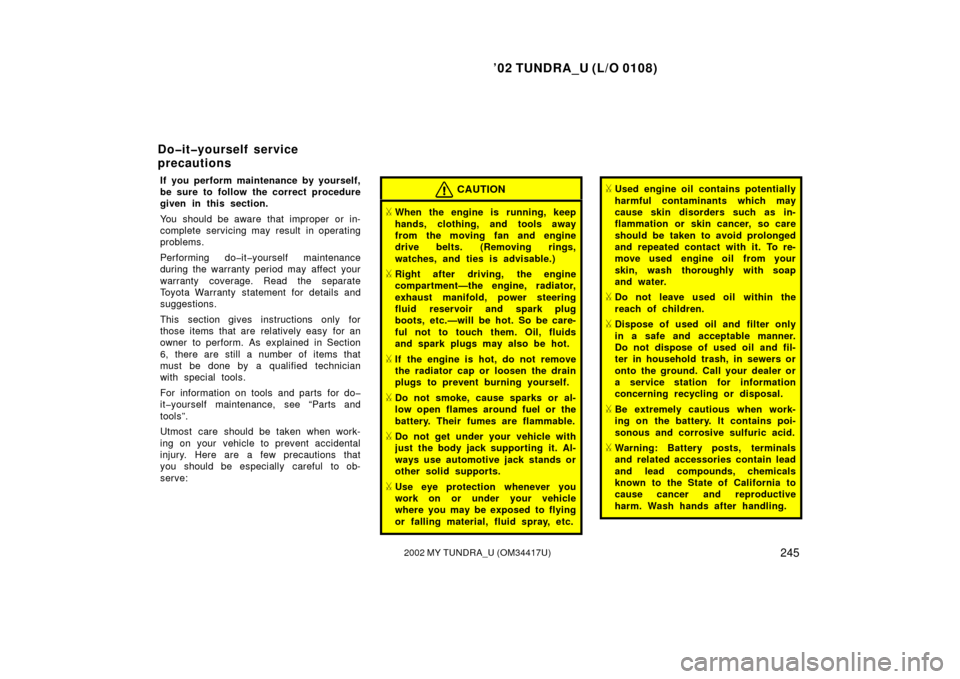Page 10 of 299
’02 TUNDRA_U (L/O 0108)
32002 MY TUNDRA_U (OM 34417U)
1. Front fog light switch
2. Headlight and turn signal switch
3. Wiper and washer switches
4. Automatic transmission selector lever
5. Cargo lamp switch
6. Emergency flasher switch
7. Note pad holder
8. Car audio
9. Air conditioning controls
10. Front passenger ’s seat belt reminder light/passenger airbag off indicator
11. Passenger airbag manual on�off switch
12. Clock
13. Cup holder
14. Power outlets
15. “4LO” button (transfer mode selector button)
16. “2WD/4HI” button (transfer mode selector button)
17. Ashtray
18. Cigarette lighter
19. Cruise control switch
20. Ignition switch
21. Tilt steering lock release lever
Page 212 of 299
’02 TUNDRA_U (L/O 0108)
2052002 MY TUNDRA_U (OM 34417U)
CAUTION
Never turn off the engine to coast
down hills. Your power steering and
brake booster will not function with-
out the engine running. Also, the
emission control system operates
properly only when the engine is run-
ning.
Page 218 of 299

’02 TUNDRA_U (L/O 0108)
2112002 MY TUNDRA_U (OM 34417U)
Do not connect the cable to or near
any part that moves when the engine
is cranked.
CAUTION
When making the connections, to
avoid serious injury, do not lean over
the battery or accidentally let the
jumper cables or clamps touch any-
thing except the correct battery termi-
nals or the ground.
5. Start your engine in the normal way.
After starting, run it at about 2000 rpm
for several minutes with the accelerator
pedal lightly depressed.
6. Carefully disconnect the cables in the exact reverse order: the negative cable
and then the positive cable.
7. Carefully dispose of the battery cover cloths—they may now contain sulfuric
acid.
8. If removed, replace all the battery vent plugs.
If the cause of your battery discharging is
not apparent (for example, lights left on),
you should have it checked. If your engine stalls while driving...
1. Reduce your speed gradually, keeping a straight line. Move cautiously off the
road to a safe place.
2. Turn on your emergency flashers.
3. Try starting the engine again.
If the engine will not start, see “If your
vehicle will not start”.
CAUTION
If the engine is not running, the pow-
er assist for the brakes and steering
will not work, so steering and braking
will be much harder than usual.
If your engine coolant temperature
gauge indicates overheating, if you ex-
perience a loss of power, or if you hear
a loud knocking or pinging noise, the
engine has probably overheated. You
should follow this procedure...
1. Pull safely off the road, stop the ve- hicle and turn on your emergency
flashers. Put the transmission in “P”
(automatic) or neutral (manual) and ap-
ply the parking brake. Turn off the air
conditioning if it is being used.
2. If coolant or steam is boiling out of the radiator or reservoir, stop the engine.
Wait until the steam subsides before
opening the hood. If there is no coolant
boiling over or steam, leave the engine
running.
CAUTION
To help avoid personal injury, keep
the hood closed until there is no
steam. Escaping steam or coolant is
a sign of very high pressure.
If your engine stalls while
driving If your vehicle overheats
Page 246 of 299

’02 TUNDRA_U (L/O 0108)
2392002 MY TUNDRA_U (OM 34417U)
Radiator, condenser and hoses
Check that the front of the radiator and
condenser are clean and not blocked with
leaves, dirt, or insects. See Section 7�2
for additional information.
Battery electrolyte level
Your Toyota has a maintenance free bat-
tery. You do not have to add distilled wa-
ter. For longer life of the battery, however,
see Section 7�3 for additional information.
Brake fluid level
Make sure the brake fluid level is correct.
See Section 7�2 for additional information.
Engine oil level
Check the level on the dipstick with the
engine turned off and the vehicle parked
on a level spot. See Section 7�2 for addi-
tional information.
Power steering fluid level (5VZ�FE en-
gine)
Check the level on the dipstick. The level
should be in the “HOT” or “COLD” range
depending on the fluid temperature. See
Section 7�2 for additional information. Power steering fluid level (2UZ�FE en-
gine)
Check the level through the reservoir. The
level should be in the “HOT” or “COLD”
range depending on the fluid temperature.
See Section 7�2 for additional information.
Exhaust system
If you notice any change in the sound of
the exhaust or smell exhaust fumes, have
the cause located and corrected immedi-
ately. (See “Engine exhaust cautions” in
Section 2.)
Be on the alert for changes in perfor-
mance, sounds, and visual tip�offs that
indicate service is needed. Some impor-
tant clues are as follows:
�Engine missing, stumbling, or pinging
�Appreciable loss of power
�Strange engine noises
�A leak under the vehicle (however, wa-
ter dripping from the air conditioning
after use is normal.)
�Change in exhaust sound (This may
indicate a dangerous carbon monoxide
leak. Drive with the windows open and
have the exhaust system checked im-
mediately.)
�Flat�looking tire; excessive tire squeal
when cornering; uneven tire wear
�Vehicle pulls to one side when driving
straight on a level road
�Strange noises related to suspension
movement
�Loss of brake effectiveness; spongy
feeling brake or clutch pedal; pedal al-
most touches floor; vehicle pulls to one
side when braking
�Engine coolant temperature continually
higher than normal
Does your vehicle need
repairing?
Page 249 of 299
’02 TUNDRA_U (L/O 0108)
2422002 MY TUNDRA_U (OM 34417U)
1. Power steering fluid reservoir
2. Engine oil level dipstick
3. Engine oil filler cap
4. Brake fluid reservoir
5. Fuse blocks
6. Battery
7. Engine coolant reservoir
8. Radiator
9. Condenser
10. Windshield washer fluid tank
Engine compartment overview
� 5VZ�FE engine
Page 250 of 299
’02 TUNDRA_U (L/O 0108)
2432002 MY TUNDRA_U (OM 34417U)
1. Power steering fluid reservoir
2. Engine oil level dipstick
3. Engine oil filler cap
4. Brake fluid reservoir
5. Fuse blocks
6. Battery
7. Engine coolant reservoir
8. Radiator
9. Condenser
10. Windshield washer fluid tank
�
2UZ�FE engine
Page 252 of 299

’02 TUNDRA_U (L/O 0108)
2452002 MY TUNDRA_U (OM 34417U)
If you perform maintenance by yourself,
be sure to follow the correct procedure
given in this section.
You should be aware that improper or in-
complete servicing may result in operating
problems.
Performing do�it�yourself maintenance
during the warranty period may affect your
warranty coverage. Read the separate
Toyota Warranty statement for details and
suggestions.
This section gives instructions only for
those items that are relatively easy for an
owner to perform. As explained in Section
6, there are still a number of items that
must be done by a qualified technician
with special tools.
For information on tools and parts for do�
it�yourself maintenance, see “Parts and
tools”.
Utmost care should be taken when work-
ing on your vehicle to prevent accidental
injury. Here are a few precautions that
you should be especially careful to ob-
serve:CAUTION
�When the engine is running, keep
hands, clothing, and tools away
from the moving fan and engine
drive belts. (Removing rings,
watches, and ties is advisable.)
�Right after driving, the engine
compartment—the engine, radiator,
exhaust manifold, power steering
fluid reservoir and spark plug
boots, etc.—will be hot. So be care-
ful not to touch them. Oil, fluids
and spark plugs may also be hot.
�If the engine is hot, do not remove
the radiator cap or loosen the drain
plugs to prevent burning yourself.
�Do not smoke, cause sparks or al-
low open flames around fuel or the
battery. Their fumes are flammable.
�Do not get under your vehicle with
just the body jack supporting it. Al-
ways use automotive jack stands or
other solid supports.
�Use eye protection whenever you
work on or under your vehicle
where you may be exposed to flying
or falling material, fluid spray, etc.
�Used engine oil contains potentially
harmful contaminants which may
cause skin disorders such as in-
flammation or skin cancer, so care
should be taken to avoid prolonged
and repeated contact with it. To re-
move used engine oil from your
skin, wash thoroughly with soap
and water.
�Do not leave used oil within the
reach of children.
�Dispose of used oil and filter only
in a safe and acceptable manner.
Do not dispose of used oil and fil-
ter in household trash, in sewers or
onto the ground. Call your dealer or
a service station for information
concerning recycling or disposal.
�Be extremely cautious when work-
ing on the battery. It contains poi-
sonous and corrosive sulfuric acid.
�Warning: Battery posts, terminals
and related accessories contain lead
and lead compounds, chemicals
known to the State of California to
cause cancer and reproductive
harm. Wash hands after handling.
Do�it�yourself service
precautions
Page 254 of 299
’02 TUNDRA_U (L/O 0108)
2472002 MY TUNDRA_U (OM 34417U)
CHECKING BRAKE FLUID
Parts (if level is low):
�SAE J1703 or FMVSS No.116 DOT 3
brake fluid
Tools:
�Rag or paper towel
�Funnel (only for adding fluid)
CHECKING POWER STEERING FLUID
Parts (if level is low):
�Automatic transmission fluid DEXRON� II
or III
Tools:
�Rag or paper towel
�Funnel (only for adding fluid)
CHECKING BATTERY CONDITION
Tools:
�Warm water
�Baking soda
�Grease
�Conventional wrench (for terminal
clamp bolts) CHECKING AND REPLACING FUSES
Parts (if replacement is necessary):
�Fuse with same amperage rating as
original
ADDING WASHER FLUID
Parts:
�Water
�Washer fluid containing antifreeze
(for winter use)
Tools:
�Funnel
REPLACING LIGHT BULBS
Parts:
�Bulb with same number and wattage
rating as original (See charts in “Re-
placing light bulbs” in Section 7�3.)
Tools:
�Screwdriver
�Wrench